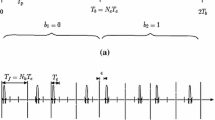Abstract
Non-coherent receivers, such as energy detectors (ED), are the simplest and the most practical alternatives to coherent receivers for low-rate and low-complexity applications in ultra-wideband (UWB) systems. However, these advantages are achieved at the expense of non-negligible performance degradation. One solution to improve the performance is to make use of time reversal (TR) technique. In this study, the performance of TR technique with non-coherent ED is analyzed in UWB systems. First, we derive an approximate analytical formula for the error probability of TR-ED which is based on tapped-delay line (TDL) channel model. Next, we theoretically and by simulations analyze the optimum integration interval which maximizes the performance of TR-ED. The results show that TR technique, by reducing the integration interval, considerably improves the performance compared to the conventional ED scheme.






Similar content being viewed by others
References
Yang, L., & Giannakis, G. (2004). Ultra-wideband communications: An idea whose time has come. IEEE Signal Processing Magazine, 21(6), 26–54.
Erküçük, S., Lampe, L., & Schober, R. (2011). Joint detection of primary systems using UWB impulse radios. IEEE Transactions on Wireless Communications, 10, 419–424.
Mishra, S. M., & Brodersen, R. W. (2007). Cognitive technology for improving ultra-wideband (UWB) coexistence. In Proceedings of IEEE ICUWB (pp. 253–258) 24–26 September 2007.
Witrisal, K., Leus, G., Janssen, G. J. M., Pausini, M., Troesch, F., Zasowski, T., et al. (2009). Noncoherent ultra-wideband systems, an overview of recent research activities. IEEE Signal Processing Magazine, 26(4), 48–66.
Quek, T. Q. S., & Win, M. Z. (2005). Analysis of UWB transmitted-reference communication systems in dense multipath channels. IEEE Journal on Selected Areas in Communications, 23(9), 1863–1874.
Dubouloz, S., Denis, B., de Rivaz, S., & Ouvry, L. (2005 September). Performance analysis of LDR UWB non-coherent receivers in multipath environments. In Proceedings IEEE international conference on ultra-wideband ICU (pp. 491–496).
Feng, W., Zhi, T., & Sadler, B. M. (2011). Weighted energy detection for noncoherent ultra-wideband receiver design. IEEE Transactions on Wireless Communications, 10(2), 710–720.
Joo, S., Chen, W., Choi, T., Oh, M., Park, J., Kim, J., & Jung, B. (2010). A fully integrated 802.15.4a IR-UWB transceiver in 0.13 m CMOS with digital RRC synthesis. In IEEE ISSCC digest of technical papers (pp. 228–229).
Gufran Khan, M., Sällberg, B., Nordberg, J., Tufvesson, F., & Claesson, I. (2011, November). Non-coherent fourth-order detector for impulse radio ultra wideband systems: empirical evaluation using channel measurements. Wireless Personal, Communication (published online: 1). doi:10.1007/s11277-011-0437-x.
Mohebbi, A., Abbasi-Moghadam, D., Shirvani Moghaddam, S., & Tabataba Vakili, V. (2010, December). Performance enhancement of Kurtosis detector using time reversal technique. In 5th International Symposium on Telecommunications (IST), IST2010
TabatabaVakili, V., Shirvani Moghaddam, S., Mohebbi, A., & Abbasi-Moghadam, D. (2011, April). Noncoherent weighted detection for time reversal UWB systems: Energy and Kurtosis detectors. International Journal on Communications Antenna and Propagation, (I.Re.C.A.P.) 1(2), 174–181.
Zhou, C., Guo, N., & Qiu, R. C. (2009). Time-reversed ultra-wideband (UWB) multiple-input multiple-output (MIMO) based on measured spatial channels. IEEE Transactions on Vehicular Technology, 58(6), 2884–2898.
Abbasi-Moghadam, D., & Tabataba Vakili, V. (2011). Characterization of indoor time reversal UWB communication systems: Spatial, temporal and frequency properties. Wiley, International Journal of Communication Systems, 24(3), 277–294.
Abbasi-Moghadam, D., & Tabataba Vakili, V. (2010). Channel characterization of time reversal UWB communication systems. Annals of Telecommunications, 65(9–10), 601–614.
Abbasi-Moghadam, D., & Tabataba Vakili, V. (June 2011). A single input-multiple output time reversal UWB communication system. Wireless Personal Communications. (published online: 04) doi:10.1007/s11277-011-0346-z.
Cassioli, D., Win, M. Z., & Molisch, A. F. (2002). The ultra-wide bandwidth indoor channel: From statistical model to simulations. IEEE Journal on Selected Areas in Communications, 20(6), 1247–1257.
Molisch, A. F. (2005). Ultrawideband propagation channels-theory, measurement, and modeling. IEEE Transactions on Vehicular Technology, 54(5), 1528–1545.
Chang, Y.-H., Tsai, S.-H., Yu, X., & Kuo, C. C. J. (2007). Ultrawideband transceiver design using channel phase precoding. IEEE Transactions on Signal Processing, 55(7), 3807–3822.
Zhang, R., & Dong, X. (2008). Synchronization and integration region optimization for UWB signals with non-coherent detection and auto-correlation detection. IEEE Transactions on Communications, 56(5), 790–798.
Molisch, A. F., Balakrishnan, K., Cassioli, D., Chong, C.-C., Emami, S., Fort, A., et al. (2004, November). IEEE 802.15.4a channel model–final report, IEEE 802.15.4a.
Chao, Y.-L., & Scholtz, R. A. (2004). Weighted correlation receivers for ultra-wideband transmitted reference systems. Proceedings of IEEE Globecom, 1, 66–70.
Author information
Authors and Affiliations
Corresponding author
Rights and permissions
About this article
Cite this article
Abbasi-Moghadam, D., Mohebbi, A. & Mohades, Z. Performance Analysis of Time Reversal UWB Communication with Non-coherent Energy Detector. Wireless Pers Commun 77, 2291–2303 (2014). https://doi.org/10.1007/s11277-014-1638-x
Published:
Issue Date:
DOI: https://doi.org/10.1007/s11277-014-1638-x




